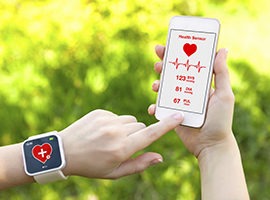
Final results from the Apple Heart study demonstrate a low probability of receiving an irregular pulse notification. It also found that 34% of those who received notification of an irregular pulse were diagnosed with atrial fibrillation (AF) on subsequent electrocardiography (ECG) patch readings, and 84% of notifications were concordant between the watch and the patch.
In the New England Journal of Medicine, authors Marco V Perez (Stanford University School of Medicine, California, USA) and colleagues write: “This siteless (no on-site visits were required for the participants), pragmatic study design provides a foundation for large-scale pragmatic studies in which outcomes or adherence can be reliably assessed with user-owned devices.”
Interpreting the findings for Cardiac Rhythm News, Perez and fellow researcher Mintu Turakhia (also Stanford University School of Medicine) said: “Because atrial fibrillation is an intermittent condition, it’s not surprising for it to go undetected in subsequent ECG patch monitoring. The study results demonstrate that this algorithm on Apple Watch can identify periods of irregular pulses and prompt subsequent clinical evaluation that confirms them to be atrial fibrillation.”
Apple Heart was a prospective single arm observational study in which participants without AF (self-reported) used an Apple iPhone app to consent to monitoring for AF. A smartwatch-based (Apple watch series 1–3) irregular pulse notification algorithm was used to identify possible AF; following notification, a telemedicine visit was arranged and an ECG patch posted to the participant, to be worn for up to seven days. Surveys were administered 90 days after notification of the irregular pulse, and at the end of the study. The main objectives were to estimate the proportion of notified participants with AF shown on an ECG patch, and the positive predictive value (PPV) of irregular pulse intervals with a targeted confidence interval width of 0.1.
During a period of eight months, the researchers recruited 419,297 participants. Over a median of 117 days of monitoring, 2,161 participants (0.52%) received notifications of irregular pulse. Among the 450 participants who returned ECG patches containing data that could be analysed—applied, on average, 13 days after notification—AF was present in 34% (97.5% confidence interval [CI] 29–39) overall, and in 35% (97.5% CI 27–43) of participants ≥65 years. Among participants who were notified of an irregular pulse, the PPV was 0.84 (95% CI 0.76–0.92) for observing AF on the ECG simultaneously with a subsequent irregular pulse notification, and 0.71 (97.5% CI 0.69–0.74) for observing AF on the ECG simultaneously with a subsequent irregular tachogram.
Of 1,376 notified participants who returned a 90-day survey, 57% contacted health care providers outside the study. And, of the 929 who completed the end-of-study survey and had a notification, 404 (44%) reported that they had received a new diagnosis of AF; 3,070 (1%) of the 293,015 who completed the end-of-study survey but did not receive a notification reported being subsequently diagnosed with AF. The notification subgroup reported a greater incidence of strokes, heart failure, and myocardial infarctions than did the non-notification group, and were also more likely to start receiving anticoagulant therapy or aspirin. There were no reports of serious app-related adverse events.
Perez and Turakhia told Cardiac Rhythm News: “The study’s findings will help patients and clinicians understand how devices like Apple Watch can play a role in identifying this deadly disease. They also lay the foundation for further research into the use of emerging wearable technologies in clinical practice and demonstrate the unique potential of large-scale app-based studies. Atrial fibrillation is just one example of wearable technology’s ability to detect health conditions, and we can look ahead to many other areas of preventive medicine.”
Perez and Turakhia also pointed out that the study showed how digital health alerts can enhance engagement with the health care system overall. “A survey of participants who received an irregular-pulse notification showed that 76% contacted either the telehealth provider or a non-study provider, suggesting that many actively sought medical attention as a result of an irregularity identified by their Apple Watch.”
The initial findings were presented earlier this year at the American College of Cardiology’s 68th Annual Scientific Session (ACC 2019; 16–18 March, New Orleans, USA).









